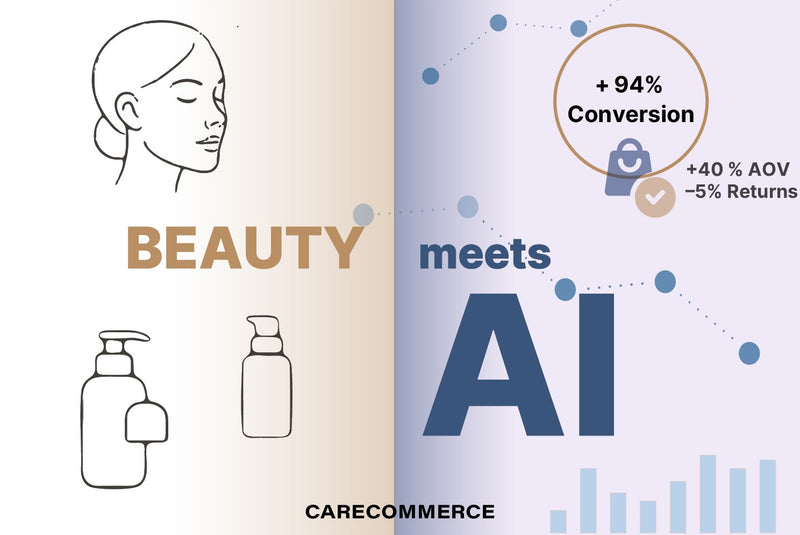Introduction
Buying skincare online is often frustrating. Many consumers don't know their skin type, resulting in incorrect purchases and returns. According to studies , 75% of German women don't know their skin type; the retention rate in beauty e-commerce is only around 23% [1] .
At the same time, the market is shifting massively to digital: Over 20% of global beauty sales are already generated online, and this share could rise to over 30% by 2030 [2] . Within the beauty segment, skincare is the strongest category [3] .
The key question is: How can brands digitally advise customers in a way that transforms uncertainty into buying confidence? The answer lies in artificial intelligence (AI) : from selfie skin analysis to personalized product recommendations , virtual try-ons (AR/VTO) , chatbots, and hyperpersonalization . AI is transforming the customer journey—while simultaneously improving conversion, shopping cart, return rates, and customer loyalty [4][5][7][10][11][13] .
State of the art
1. Digital skin analysis via selfie
Selfie-based tools analyze skin type, pores, moisture, and oil content and provide specific recommendations. Douglas integrated AI skin analysis into its app in 2022 and reported higher conversion rates , fewer incorrect purchases, and fewer returns [4] . The international Olay Skin Advisor even achieved 2× higher conversion and a 40% increase in shopping cart values [5] .
The mechanism is clear: diagnosis reduces uncertainty and creates trust – and trust in e-commerce is directly measurable in sales [4][5] .
2. Personalized product recommendations
Recommendation engines consider skin type, purchasing behavior, and preferences in real time. Flaconi uses Dynamic Yield, among other things, for this purpose [6] . Studies show: +5–15% sales and +10–30% efficiency ; pioneers even achieve approximately 40% more sales growth [7] . Additionally, personalization tools increase the AOV by up to +12% [8] .
3. Virtual fitting (AR/VTO)
Virtual try-ons lower purchase barriers. Douglas uses the "Beauty Mirror" for this purpose [9] . Shopify reports that products with 3D/AR achieve an average conversion rate of 94% [10] . NARS × Perfect Corp even achieved a conversion rate of 300% and a total of 40% [11] . Individual cases also show a 5% drop in returns [12] .
4. AI chatbots & digital advisors
Chatbots advise customers in real time. Sephora used a messenger assistant and achieved an 11% increase in booking conversion [13] . Brands like Estée Lauder and L'Oréal also use bots for advice and purchase recommendations [14] .
5. Hyperpersonalization
Hyperpersonalization combines diagnostic data, purchasing behavior, and CRM. Over 50% of customers are willing to share data for better recommendations [15] . McKinsey proves: Personalization leaders generate ~40% more revenue [7] . AI also supports product development by evaluating customer feedback and trends [16] .
Potential: Why shops must act now
- Increase conversion & reduce returns: Douglas shows that AI-supported skin analysis reduces incorrect purchases and increases conversion [4] .
- Higher shopping basket values: Studies show that personalized recommendations lead to larger shopping baskets and stronger customer loyalty [10] .
- Strengthening brand image: Innovative consulting solutions such as selfie analysis or AR position brands as digital pioneers [11] .
- More efficient product development: AI evaluates customer feedback and market trends, supports more precise developments and reduces overproduction [16] .
Practical examples from DACH and internationally
- Douglas (Germany): AI skin analysis → higher conversion, fewer returns [4] .
- Flaconi (Germany): Recommendation platform → Conversion +15%, AOV +20% [6][8] .
- NordicFeel (Scandinavia): Selfie analysis with Revieve → >20% put recommended products in the shopping cart [17] .
- NARS (International): Virtual Try-On → Conversion +300%, AOV +40% [11] .
- Sephora (International): Messenger Assistant → Conversion +11% [13] .
- Revieve (International): Digital beauty advisors increased conversion by +232–275% in case studies [18] .
Opportunities & Risks
| chance | risk | Solution |
|---|---|---|
| More conversion, fewer returns | Skin type bias (light vs. dark skin) | Choose providers with diverse databases |
| Better customer experience | GDPR risks with selfie data | Clear consent, anonymized storage |
| Brand positioning as an innovator | Excessive customer expectations | No promises of healing, clear communication |
| Data-driven optimization | Technical hurdles & loading times | Mobile First & UX Optimization |
Recommendations for shop operators
- Launch your MVP: Start with a skin quiz or simple AI tool.
- Prioritize data protection: GDPR-compliant consent is mandatory.
- Optimize mobile UX: Tools must work quickly, easily, and mobile-first.
- Use marketing: Make AI analysis your USP (“Find your routine with a selfie”).
- Measure KPIs: Systematically track conversion, shopping cart value, and repeat purchase rate.
Conclusion
AI isn't a trend, it's a must in skincare e-commerce. Whether it's selfie diagnostics, recommendation engines, VTO, or chatbots, all cases show clear effects: higher conversions, larger shopping carts, fewer returns, and stronger loyalty . Those who invest now will gain a head start – with customers and with Google.
Want to know how AI & personalization can make your skincare shop more successful?
CARECOMMERCE supports you with strategy, tool selection, and implementation – so that your shop offers the future of skincare today.




